Study on Ultrathin Silver Film Transparent Electrodes Based on Aluminum Seed Layers with Different Structures
Abstract
1. Introduction
2. Model and Experiment
2.1. Model of Thin Metal Film Growth
2.2. Experiment
2.3. Thin Film Characterization
3. Results and Discussion
3.1. Preparation of Single Layer Silver Film
3.2. Optimization of Seed Layer Thickness
3.3. Optimization of Silver Film Thickness
3.4. Optimization of Preparation Method for Aluminum Seed Layer
4. Conclusions
Author Contributions
Funding
Data Availability Statement
Acknowledgments
Conflicts of Interest
References
- Wang, W.; Song, M.; Bae, T.S.; Park, Y.H.; Kang, Y.C.; Lee, S.G.; Kim, S.Y.; Kim, D.H.; Lee, S.; Min, G.; et al. Transparent ultrathin oxygen-doped silver electrodes for flexible organic solar cells. Adv. Funct. Mater. 2014, 24, 1551–1561. [Google Scholar] [CrossRef]
- Song, J.; Hou, P.X.; Chen, M.L.; Sun, D.M.; Tang, D.M.; Jin, Q.; Guo, Q.X.; Zhang, D.D.; Du, J.H.; Tai, P.H.; et al. Ultrahigh-performance transparent conductive films of carbonwelded isolated single-wall carbon nanotubes. Sci. Adv. 2018, 4, eaap9264. [Google Scholar]
- Zhang, C.; Huang, Q.Y.; Cui, Q.Y.; Ji, C.G.; Zhang, Z.; Chen, X.; George, T.; Zhao, S.; Guo, L.J. High-performance large-scale flexible optoelectronics using ultrathin silver films with tunable properties. ACS Appl. Mater. Interfaces 2019, 11, 27216–27225. [Google Scholar] [CrossRef] [PubMed]
- Nam, V.B.; Shin, J.; Yoon, Y.; Giang, T.T.; Kwon, J.; Suh, Y.D.; Yeo, J.; Hong, S.; Ko, S.H.; Lee, D. Highly stable Ni-based flexible transparent conducting panels fabricated by laser digital patterning. Adv. Funct. Mater. 2019, 29, 1806895. [Google Scholar] [CrossRef]
- Wu, H.; Kong, D.S.; Ruan, Z.C.; Wang, S.; Yu, Z.; Carney, T.J.; Hu, L.; Fan, S.; Cui, Y. A transparent electrode based on a metal nanotrough network. Nat. Nanotechnol. 2013, 8, 421–425. [Google Scholar] [CrossRef] [PubMed]
- Cao, W.R.; Li, J.; Chen, H.Z.; Xe, J. Transparent electrodes for organic optoelectronic devices: A review. J. Photonics Energy 2014, 4, 040990. [Google Scholar] [CrossRef]
- Tian, Z.; Yan, H.; Peng, Q.; Guo, L.J.; Zhou, S.; Ding, C.; Li, P.; Luo, Q. Atomistic Insights into Aluminum Doping Effect on Surface Roughness of Deposited Ultra-Thin Silver Films. Nanomaterials 2021, 11, 158. [Google Scholar] [CrossRef]
- Colenso, H.R.; Rafealov, E.Z.; Maddahb, M.; Plank, N.O.V.; Chenc, W.-T.; Waterhousec, G.I.N.; Hao, J.J.; Gouws, G.J.; Moore, C.P. Comparison of seed layers for smooth, low loss silver films used in ultraviolet-visible plasmonic imaging devices. Thin Solid Films 2018, 656, 68–74. [Google Scholar] [CrossRef]
- Liu, H.; Wang, B.; Leong, E.S.; Yang, P.; Zong, Y.; Si, G.; Teng, J.; Maier, S.A. Enhanced Surface Plasmon Resonance on a Smooth Silver Film with a Seed Growth Layer. ACS Nano 2010, 4, 3139–3146. [Google Scholar] [CrossRef]
- Formica, N.; Ghosh, D.S.; Carrilero, A.; Chen, T.L.; Simpson, R.E.; Pruneri, V. Ultrastable and Atomically Smooth Ultrathin Silver Films Grown on a Copper Seed Layer. ACS Appl. Mater. Interfaces 2013, 5, 3048–3053. [Google Scholar] [CrossRef]
- Schwab, T.; Schubert, S.; Müller-Meskamp, L.; Leo, K.; Gather, M.C. Eliminating Micro-Cavity Effects in White Top-Emitting OLEDs by Ultra-Thin Metallic Top Electrodes. Adv. Opt. Mater. 2013, 1, 921–925. [Google Scholar] [CrossRef]
- Stefaniuk, T.; Wróbel, P.; Trautman, P.; Szoplik, T. Ultrasmooth metal nanolayers for plasmonic applications: Surface roughness and specific resistivity. Appl. Opt. 2014, 53, B237–B241. [Google Scholar] [CrossRef] [PubMed]
- Logeeswaran, V.J.; Kobayashi, N.P.; Islam, M.S.; Wu, W.; Chaturvedi, P.; Fang, N.X.; Wang, S.Y.; Williams, R.S. Ultrasmooth silver thin films deposited with a germanium nucleation layer. Nano Lett. 2009, 9, 9178–9182. [Google Scholar] [CrossRef] [PubMed]
- Lv, J.; Lin, Y.-Z.; Lin, S.-Y.; Lin, L.-M.; Wu, X.-C.; Lai, F.-C. The effect of intermediate layer on electrical and optical properties of Ag films. Fujian Norm. Univ. (Nat. Sci. Ed.) 2008, 2, 43–46. [Google Scholar]
- Xue, W.N. Growh and Properties of Ultrasmooth Al-Doped Silver Films on Glass Substrates; Zhejiang University: Hangzhou, China, 2018. [Google Scholar]
- Gu, D.; Zhang, C.; Wu, Y.K.; Guo, L.J. Ultrasmooth and thermally stable silver-based thin films with subnanometer roughness by aluminum doping. ACS Nano 2014, 8, 10343. [Google Scholar] [CrossRef]
- Costa, J.C.S.; Coelho, A.F.S.M.G.; Mendes, A.; Santos, L.M.N.B.F. Nucleation and Growth of Microdroplets of Ionic Liquids Deposited by Physical Vapor Method onto Different Surfaces. Appl. Surf. Sci. 2018, 428, 242–249. [Google Scholar] [CrossRef]
- Yun, J. Ultrathin Metal Films for Transparent Electrodes of Flexible Optoelectronic Devices. Adv. Funct. Mater. 2017, 27, 1606641. [Google Scholar] [CrossRef]
- Xu, J.J.; Huang, J.H.; Sheng, W.; Wang, Z.; Zhao, W.; Li, J.; Yang, Y.; Wan, D.; Song, W. Research progress on ultrathin metal transparent conductive films and their applications. Mater. Rep. 2019, 33, 1875–1881. [Google Scholar]
- Kaiser, N. Review of the fundamentals of thin-film growth. Appl. Opt. 2022, 41, 3053–3060. [Google Scholar] [CrossRef]
- Vitos, L.; Ruban, A.V.; Skriver, H.L.; Kollár, J. The surface energy of metals. Surf. Sci. 1998, 411, 186–202. [Google Scholar] [CrossRef]
- Zhan, G.; Chen, G.J.; Park, Y.B. Thin-Metal-Film based transparent conductors: Material preparation, optical design, and device appliactions. Adv. Opt. Mater. 2021, 9, 2001298. [Google Scholar] [CrossRef]
- Overbury, S.H.; Bertrand, P.A.; Somorjai, G.A. Surface composition of binary systems. Prediction of surface phase diagrams of solid solutions. Chem. Rev. 1975, 75, 547–560. [Google Scholar] [CrossRef]
- Sangiorgi, R.; Muolo, M.L.; Chatain, D.; Eustathopoulos, N. Wettability and Work of Adhesion of Nonreactive Liquid Metals on Silica. Am. Ceram. Soc. 2022, 71, 742–748. [Google Scholar] [CrossRef]
- Bauer, E. Phänomenologische Theorie der Kristallabscheidung an Oberflächen II. Zeitschrift für Kristallographie-Crystalline Materials. 1958, 110, 395. [Google Scholar] [CrossRef]
- Li, D.; Pan, Y.Q.; Liu, H.; Zheng, Z.Q.; Zhou, Z.L. Ultra-thin silver transparent conductive film based on aluminum infiltration layer. J. Appl. Opt. 2022, 43, 980–985. [Google Scholar] [CrossRef]
- Lu, J.J.; Li, X.Y.; Sun, X.P. Effect of film thickess on optical constants of metal film. Opt. Tech. 2012, 38, 602–606. [Google Scholar]
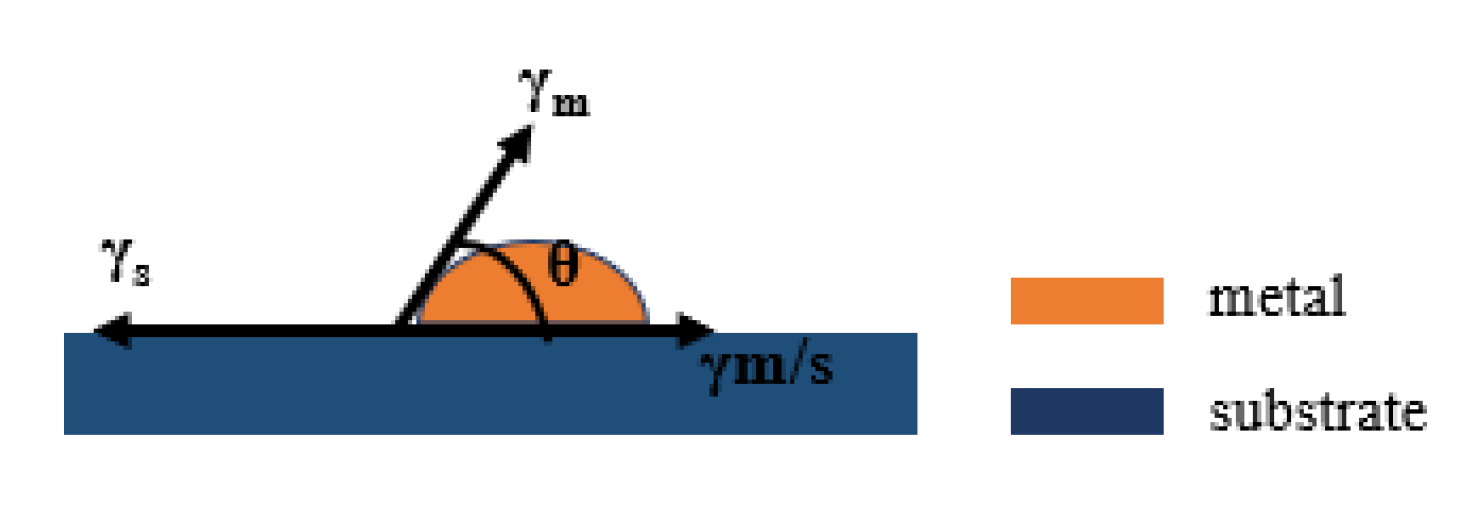
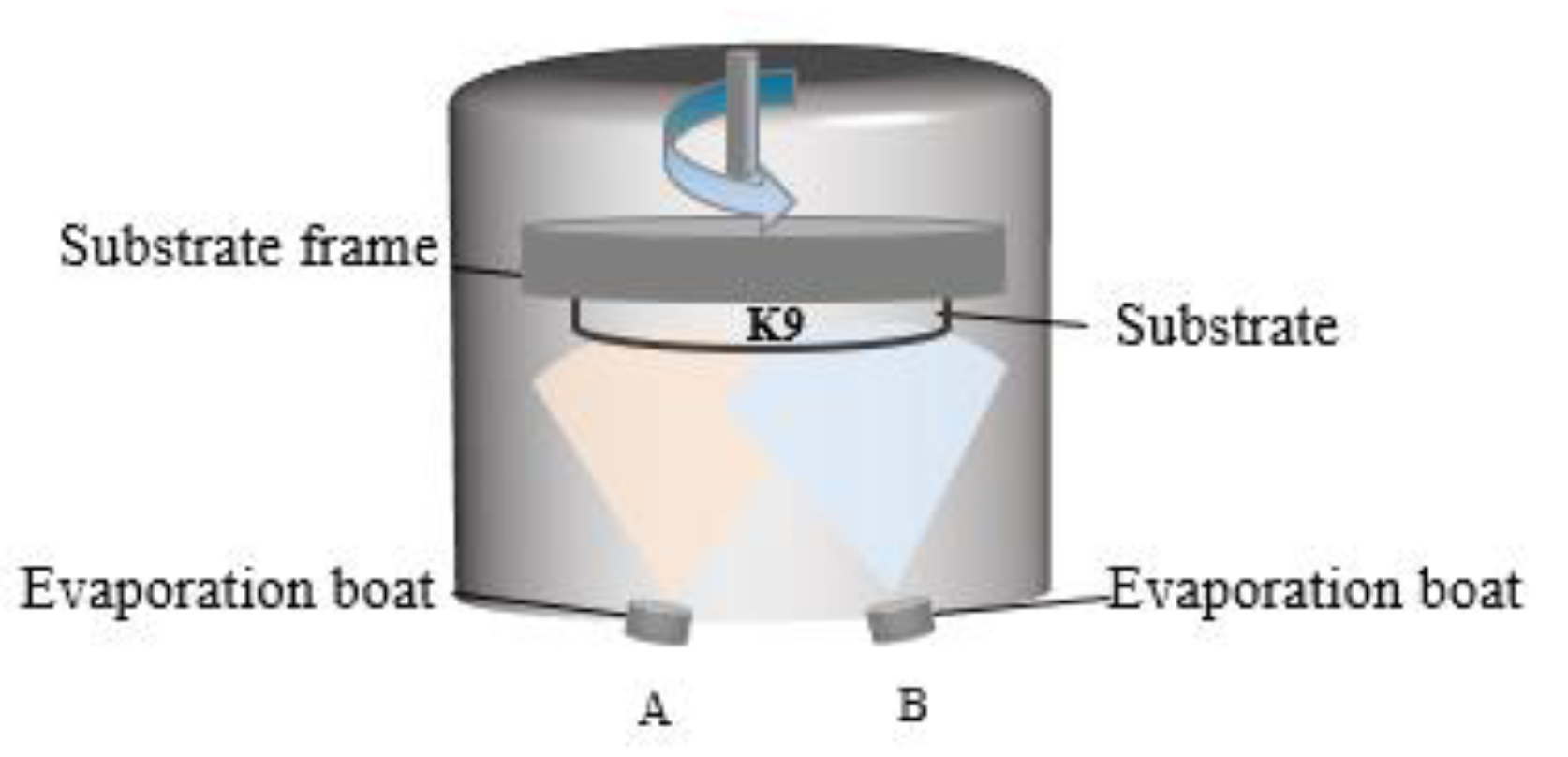
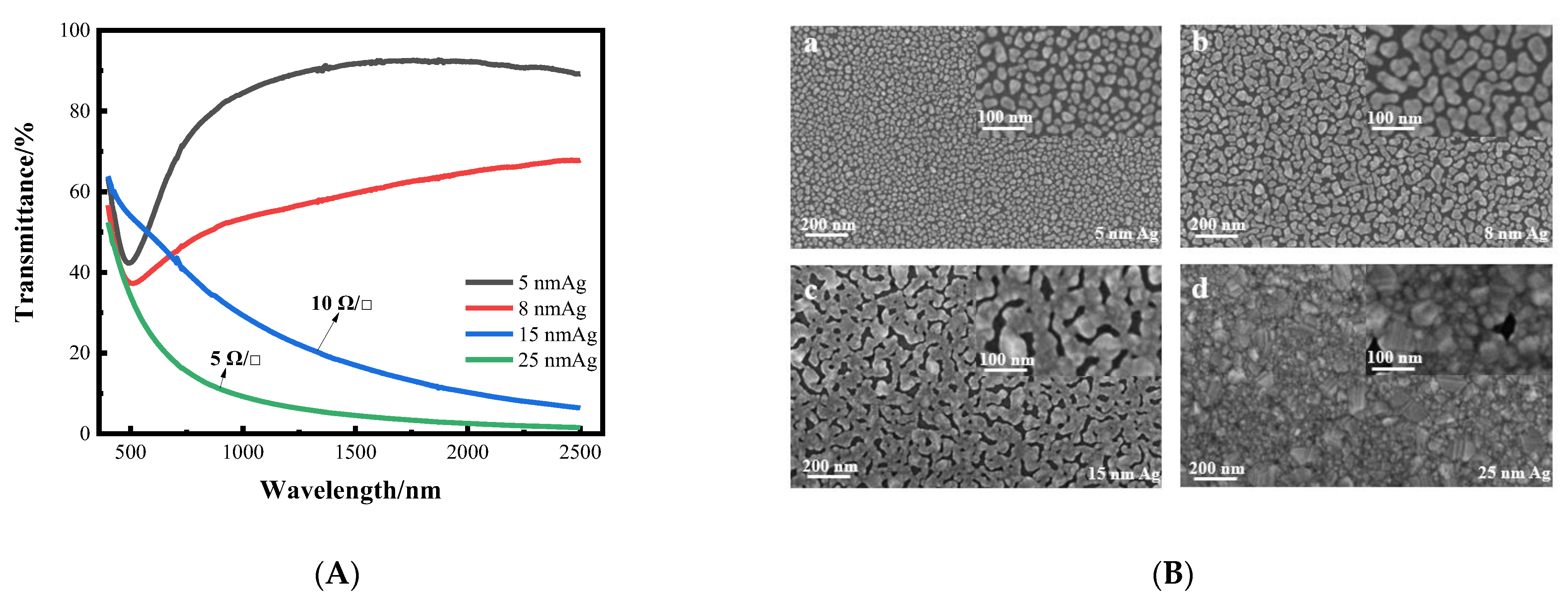
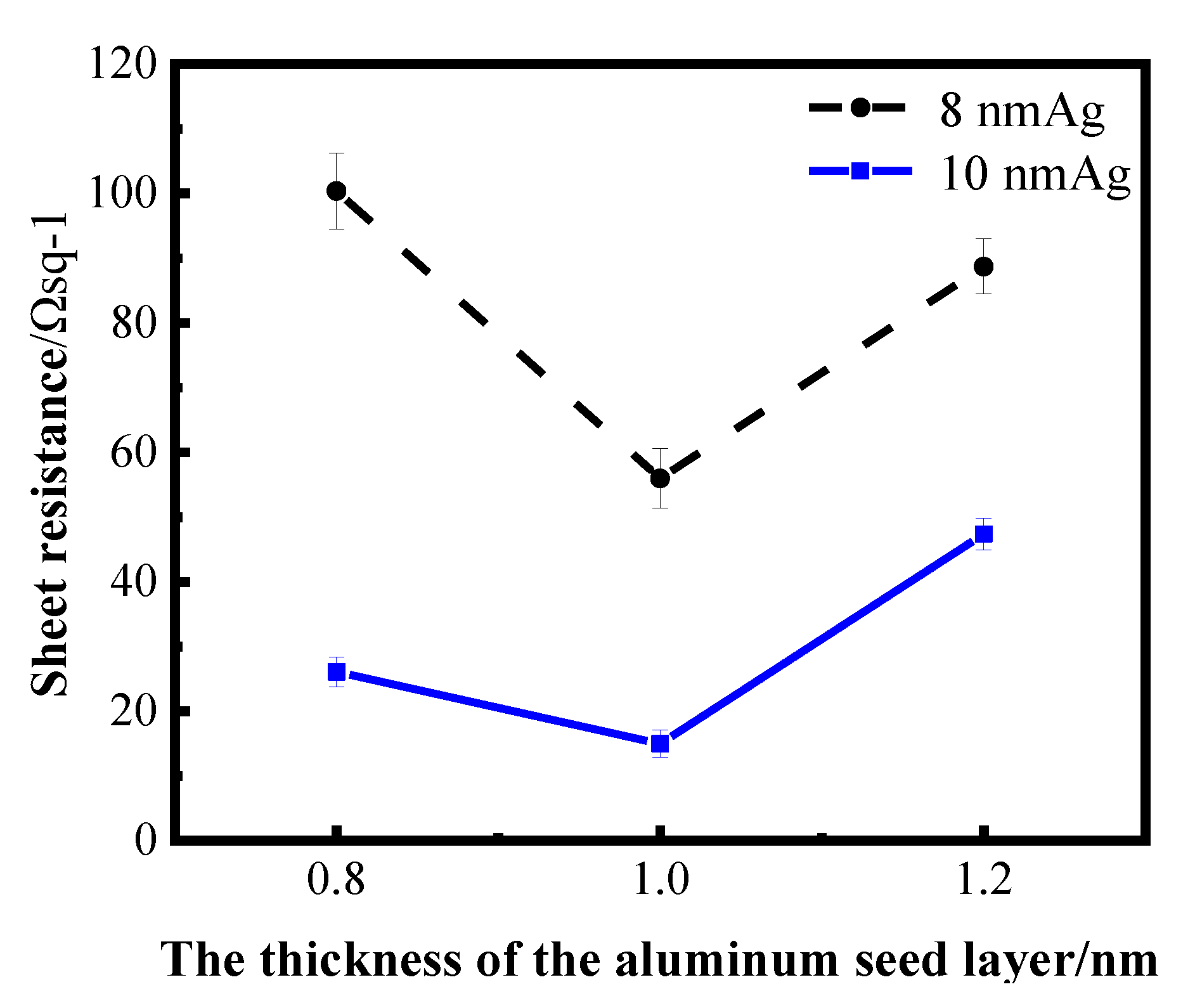
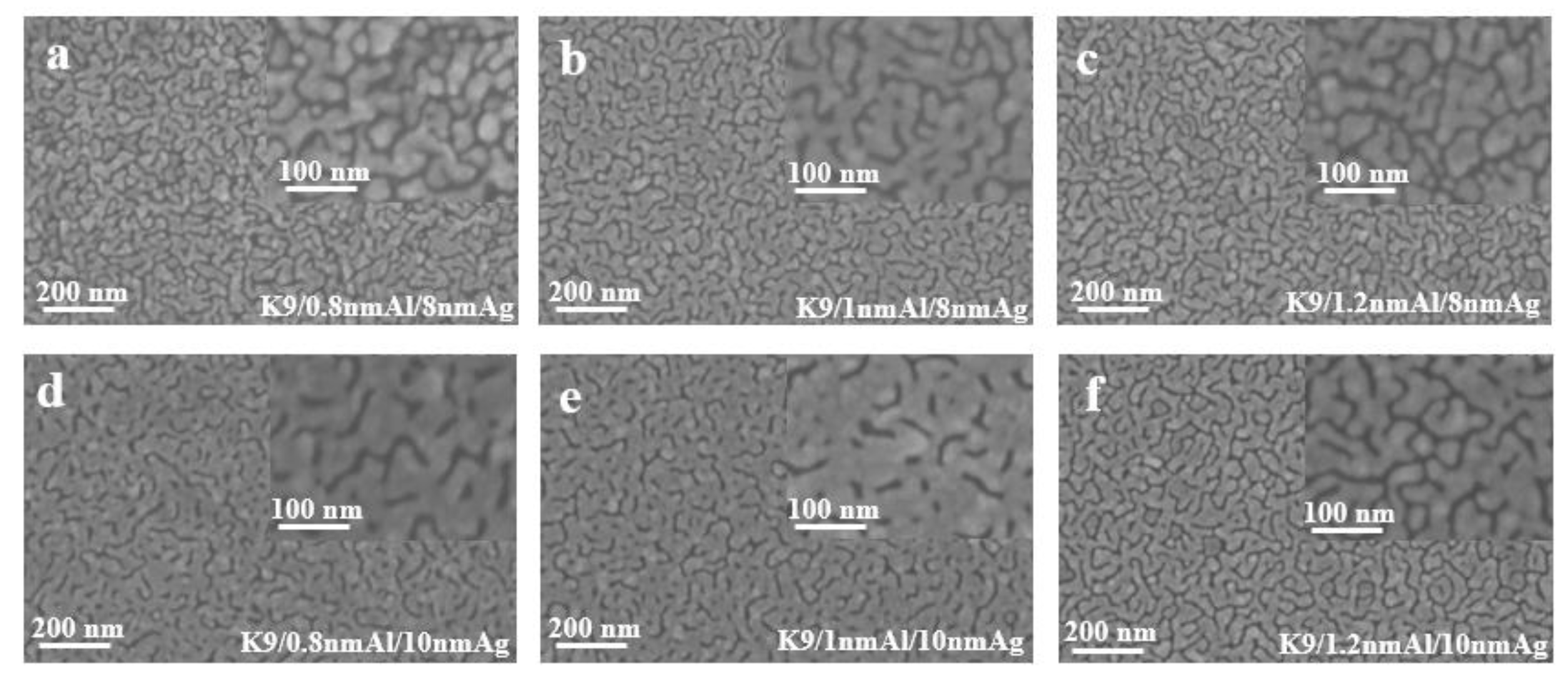




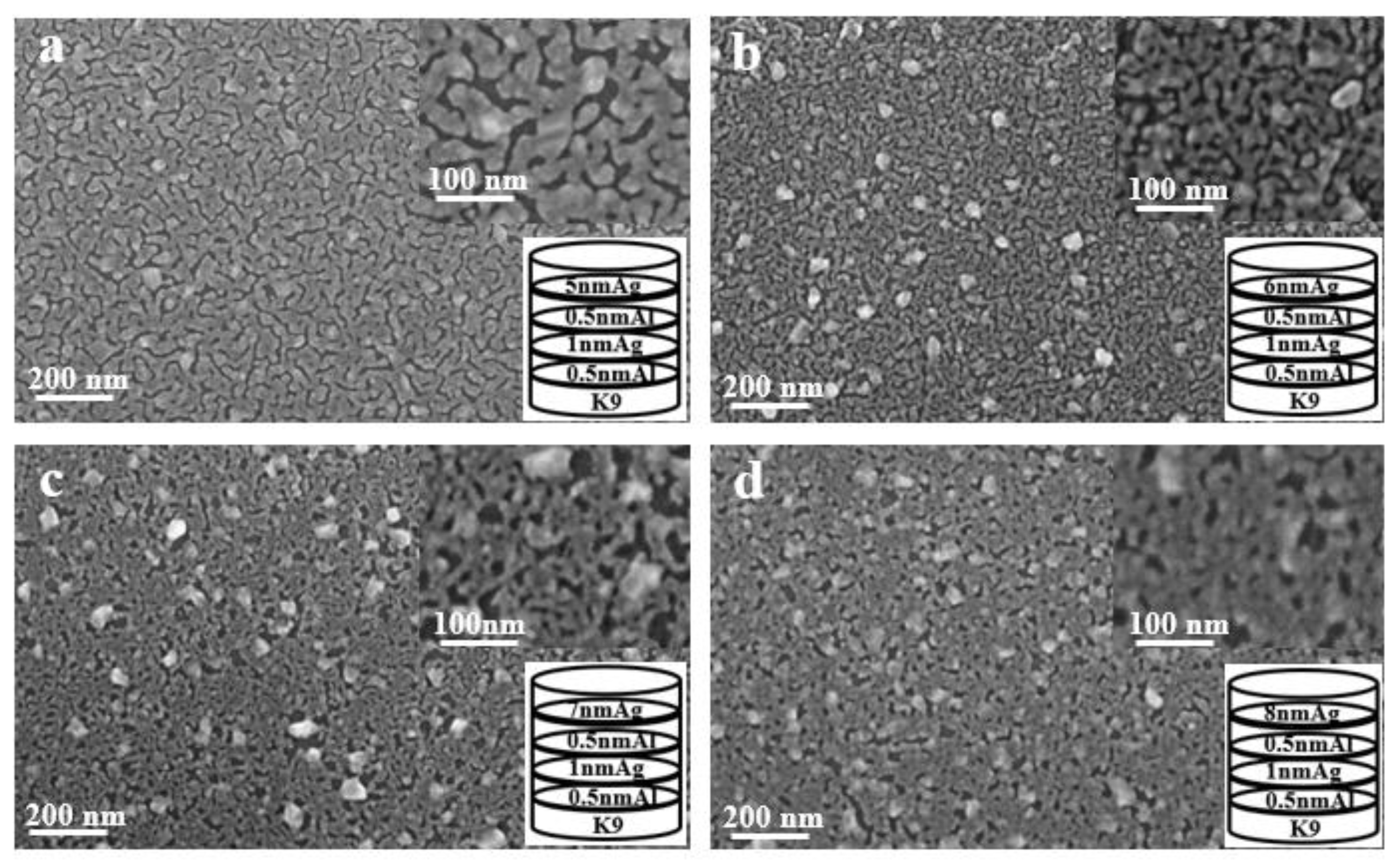
Publisher’s Note: MDPI stays neutral with regard to jurisdictional claims in published maps and institutional affiliations. |
© 2022 by the authors. Licensee MDPI, Basel, Switzerland. This article is an open access article distributed under the terms and conditions of the Creative Commons Attribution (CC BY) license (https://creativecommons.org/licenses/by/4.0/).
Share and Cite
Li, D.; Pan, Y.; Liu, H.; Zhang, Y.; Zheng, Z.; Zhang, F. Study on Ultrathin Silver Film Transparent Electrodes Based on Aluminum Seed Layers with Different Structures. Nanomaterials 2022, 12, 3540. https://doi.org/10.3390/nano12193540
Li D, Pan Y, Liu H, Zhang Y, Zheng Z, Zhang F. Study on Ultrathin Silver Film Transparent Electrodes Based on Aluminum Seed Layers with Different Structures. Nanomaterials. 2022; 12(19):3540. https://doi.org/10.3390/nano12193540
Chicago/Turabian StyleLi, Dong, Yongqiang Pan, Huan Liu, Yan Zhang, Zhiqi Zheng, and Fengyi Zhang. 2022. "Study on Ultrathin Silver Film Transparent Electrodes Based on Aluminum Seed Layers with Different Structures" Nanomaterials 12, no. 19: 3540. https://doi.org/10.3390/nano12193540
APA StyleLi, D., Pan, Y., Liu, H., Zhang, Y., Zheng, Z., & Zhang, F. (2022). Study on Ultrathin Silver Film Transparent Electrodes Based on Aluminum Seed Layers with Different Structures. Nanomaterials, 12(19), 3540. https://doi.org/10.3390/nano12193540





